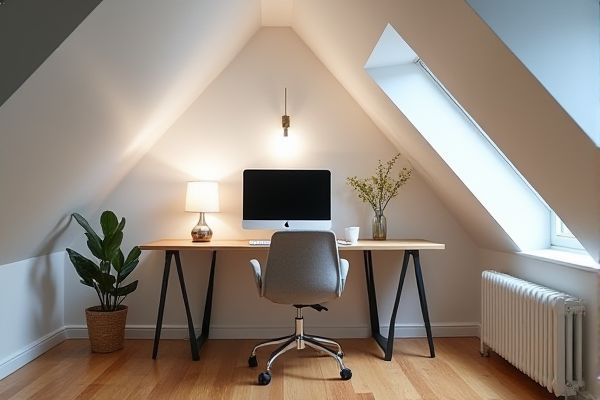
Wall-hung desks save valuable floor space in your attic, offering a sleek, customizable option ideal for smaller areas, while standing desks promote better posture and increased energy by allowing you to alternate between sitting and standing. Explore the full article to discover which desk type best suits your attic workspace and personal productivity needs.
Table of Comparison
| Feature | Wall-Hung Desk | Standing Desk (Attic) |
|---|---|---|
| Space Efficiency | Highly space-saving; mounted on the wall, ideal for small attics | Requires floor space; may limit attic movement |
| Installation | Requires strong wall anchors; moderate installation effort | Freestanding; simple setup but requires floor leveling |
| Ergonomics | Fixed height unless adjustable mount is used | Adjustable height; promotes better posture and movement |
| Storage Options | Limited storage; surface only | Typically includes drawers or shelves |
| Mobility | Fixed position; not movable | Portable or repositionable options available |
| Cost | Generally lower cost | Higher price due to adjustability and features |
| Aesthetic Fit for Attic | Minimalist and clean look; blends with attic slants | Bulkier; may clash with limited attic headroom |
Wall-Hung Desk vs Standing Desk: Choosing the Best for Your Attic Workspace
Wall-hung desks maximize attic space by providing a compact, foldable surface ideal for small or sloped areas, enhancing flexibility without sacrificing floor area. Standing desks offer ergonomic benefits, promoting better posture and energy levels, but require sufficient attic height and stability to be practical. Selecting between a wall-hung desk and a standing desk depends on attic dimensions, user comfort preferences, and workspace functionality needs.
Space Efficiency in Attic Offices: Wall-Hung vs Standing Desks
Wall-hung desks maximize space efficiency in attic offices by utilizing vertical wall space, freeing up valuable floor area for movement and storage. Standing desks often require a larger footprint, which can limit usable space in compact attic environments. Your choice between these desk types should consider the attic's dimensions and how much open floor space you need for comfort and organization.
Ergonomics: Comfort and Health in Small Attic Setups
Wall-hung desks in attic spaces optimize ergonomics by saving floor space and allowing customizable height adjustments to reduce strain on the back and neck. Standing desks encourage movement and improve circulation, which helps prevent sedentary health issues common in compact attic setups. Choosing between the two depends on personal comfort preferences and available attic dimensions to maintain proper posture and long-term musculoskeletal health.
Installation and Setup Requirements in Attic Spaces
Wall-hung desks in attic spaces require secure wall mounting, often challenging due to sloped ceilings and limited stud locations, but save valuable floor area ideal for compact attic rooms. Standing desks in attics need stable floor placement and sufficient headroom to accommodate adjustable height mechanisms, which can be restricted by low or angled ceilings. Installation of wall-hung desks demands precise measurements and reinforcement, whereas standing desks offer more flexibility but may consume more floor space in confined attic environments.
Customization Options: Wall-Hung vs Standing Desks
Wall-hung desks offer limited customization, primarily constrained by wall space and mounting options, making them ideal for small attics with fixed layouts. Standing desks provide extensive customization through adjustable heights and modular accessories, allowing you to tailor the workspace ergonomically and functionally. Your choice depends on how much flexibility and personalized configuration you need for your attic office setup.
Storage Solutions: Maximizing Attic Desk Functionality
Wall-hung desks in an attic optimize storage by utilizing vertical space, freeing your floor area for additional shelves or storage bins. Standing desks enhance functionality with adjustable heights, allowing you to incorporate under-desk storage options like rolling cabinets or drawer units. Both designs can maximize attic space efficiency by combining ergonomic work surfaces with smart storage solutions tailored to your unique spatial constraints.
Aesthetics and Design Appeal in Attic Workspaces
Wall-hung desks offer a minimalist, space-saving design that seamlessly integrates into attic workspaces, enhancing clean lines and maximizing floor area. Standing desks in attics provide ergonomic benefits but often require bulkier bases, which can disrupt the visual flow and limit creative design options in sloped ceilings. Choosing a wall-hung desk elevates the aesthetic appeal by creating an open, airy environment that complements the unique angles and natural light of attic rooms.
Budget Considerations for Attic Desks
Wall-hung desks typically offer a budget-friendly solution for attic spaces, requiring less material and installation cost compared to standing desks, which often involve more complex height-adjustment mechanisms. Standing desks for attics can be more expensive due to specialized designs accommodating sloped ceilings and limited space, but they provide ergonomic benefits and flexibility. Your choice depends on balancing initial cost with long-term comfort and productivity enhancements.
User Experience: Attic Desk Reviews and Feedback
Users of wall-hung desks in attic spaces highlight their space-saving design and ease of installation, which maximizes limited area without sacrificing functionality. Standing desks in attics receive positive feedback for promoting better posture and reducing back pain, although some report challenges with uneven flooring affecting stability. Overall, attic desk reviews emphasize comfort, ergonomic benefits, and efficient use of vertical space as key factors influencing user satisfaction.
Pros & Cons: Wall-Hung Desk vs Standing Desk in Attic Rooms
Wall-hung desks in attic rooms maximize space efficiency by freeing floor area and offering a sleek, minimalistic design ideal for limited spaces but may lack ergonomic adjustability and storage options. Standing desks provide improved posture and health benefits through vertical workspace flexibility but can be bulky in confined attic areas and may require additional structural support. Choosing between the two depends on balancing attic room dimensions, ergonomic needs, and aesthetic preferences for optimal functionality.
 homyna.com
homyna.com